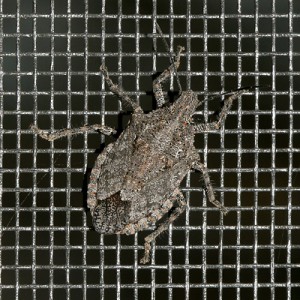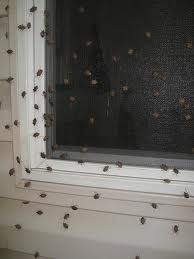Stink Bugs Return In Greater Force
Experts are warning that the fall stink bug plague is returning with a vengeance; this time as unwelcome house guests.
They are not known to carry disease but they do bite, cause massive crop damage, are evasive because they can fly, and when squashed emit a horrible garbage-like stench.
Why couldn’t Noah have left these guys off the Arc, eh?
Or rather, why must we rely so much on imported goods that we usher in such unwanted hitch hikers? The insects come from China, Japan and Korea. They ruin our crops like the $37 million worth of apples causing us to rely more on…you guessed it, imports from those countries.
There is talk of growing “trap crops” to lure them away from food crops and for bringing in more species of bugs to fight them. In the home, it is suggested to first, try to prevent them from entering, but if they should, vacuum them up and throw out the bag.
~Health Freedoms
Infestation of the stink bug: America braces itself for plague of pest with unbearable smell
They are hideous pests which invaded U.S. homes last year, emitting an unbearable stench and wreaking havoc on crops.
And it looks like the country is in for another shock, after experts warned that the bugs are coming back with a vengeance.
Brown marmorated stink bugs, which cost the mid-Atlantic’s apple crop $37million last year, have woken from hibernation, mated and are looking to settle in the cracks of our homes, experts have warned.
This year’s influx are the offspring of the plague last fall which terrified homeowners in Maryland, West Virginia and Pennsylvania.
After feasting on crops they entered houses to hibernate in the warmth of human homes.
‘If they get to Florida, it could be like the atomic bomb going off’
Douglas G. Luster, researcher
They do however bite you, eat your plants and vegetables and emit an appalling stench when they are squeezed that resembles decaying garbage.
They are also almost impossible to get rid of and have wings which means they fly off when you try to catch them.
Hailing originally from China, Japan and Korea each stink bug has the capacity to lay up to 30 eggs per nesting session.
They are transported long distances by cargo containers or from garden to garden simply by the wind when it is strong enough to carry them.
This year, they started waking up and mating in late May. Within three weeks their eggs had hatched and the nymphs, or offspring, matured just six weeks later.
It is thought that they will start invading people’s homes in late September – and the plague is set to be worse than last year’s in many areas, according to government entomologists.
In particular, there is concern about the fact that the species is from Asia, so there are no natural predators in the U.S. to fight them off.
The creatures prefer warm climates and are expected to start migrating south east from Pennsylvania.
‘If they get to Florida, it could be like the atomic bomb going off,’ Douglas G. Luster, research leader for the U.S. Department of Agriculture’s Agricultural Research Service, told the Washington Post.
‘They’re starting to show up in North Carolina.’
The Environmental Protection Agency have approved two insecticides to try to control the bugs and researchers are investigating the possibility of importing predators, such as non-stinging parasitic wasps, over from Asia.
‘The growers who have the most fear are the fruit growers,’ Jerry Bruste, secretary and treasurer for the Maryland Vegetable Growers Association said. ‘It will devastate them.’
Sightings of the brown marmorated stink bug have been reported in 33 states so far this year, a rise of eight since fall alone.
The pest appears to be spreading from its traditional home in the mid-Atlantic coast throughout America, experts said.
The only areas to escape the epidemic are the Rockies and the Plains but everywhere else homeowners have found thousands of the dime-sized creatures infesting their homes in beds and in sofas.
So far this year the bugs have been spotted as far west as California, in Minnesota to the North and Florida in the South.
March of the stink bugs:
- The brown marmorated stink bug – or Halyomorpha halys – is not native to the U.S.
- First found in Allentown, Pennsylvania, in 1998, it is believed to have been introduced into the east of the state a few years earlier.
- While not dangerous, it is clear when a stink bug is around due to the appalling smell it emits when squashed or crushed.
- The insect does not transmit disease and is not poisonous, but can bite humans. It also likes to eat plants and vegetables.
- Irritatingly, the stink bug is extremely difficult to catch as it can simply fly away.
- Coming from the insect family Pentatomidae, it is well known as an agricultural pest in its native habitat of China, Japan, Korea and Taiwan.
- In recent years it has feasted on crops on islands in the mid-Atlantic and is now feared to become a regular feature in the U.S. in summers to come, although it sometimes surfaces during sunny winter days.
- An adult stink bug is around 17mm long and is almost as wide.
- Its scent glands, which are found on the dorsal surface of the abdomen and underside of the thorax, are responsible for its repulsive stink.
- It typically lays yellow or yellow/red eggs on the underside of leaves in batches of 20 to 30.
By PAUL BENTLEY
Sources:
http://stinkbugsguide.net/infestation.htm
Health Freedom Alliance
Health & Wellness Foundation
CHAD Foundation
http://www.healthfreedomalliance.org

